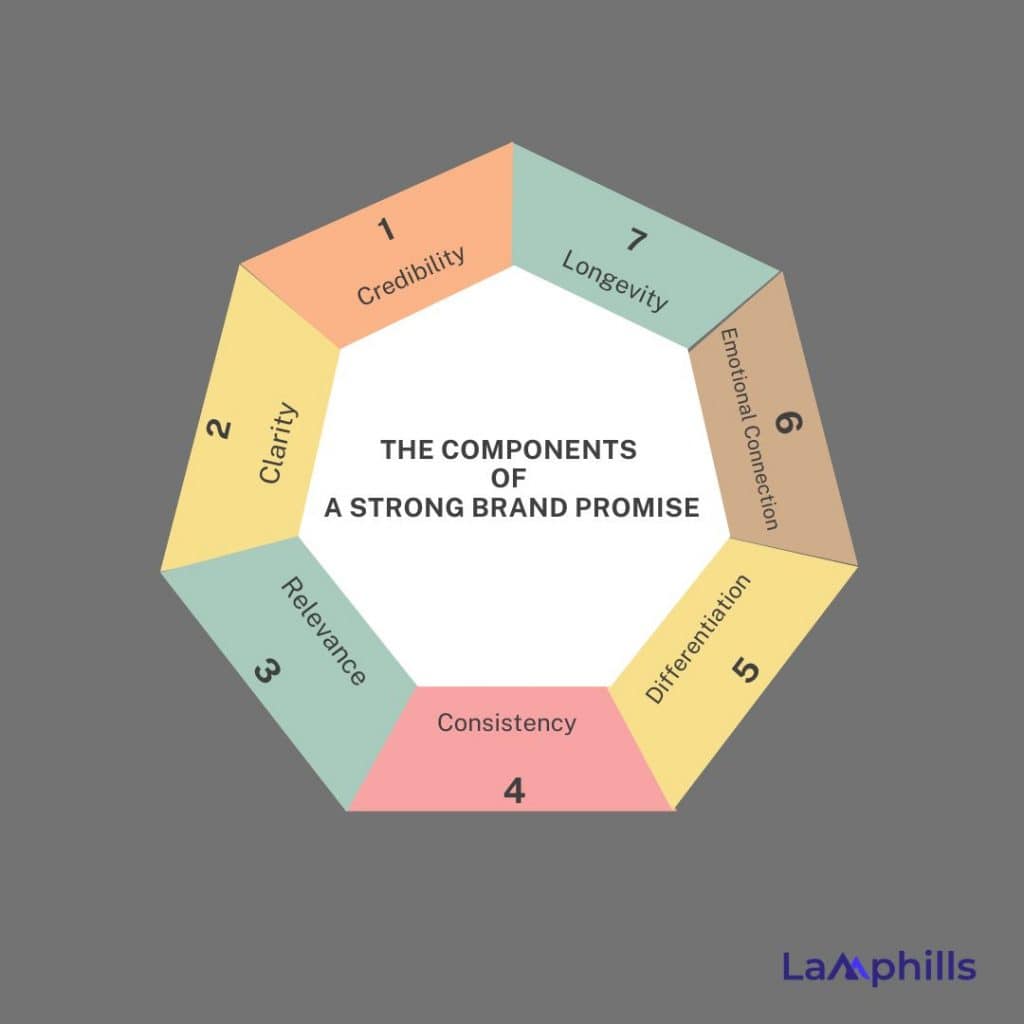Branding is crucial to a company’s marketing strategy and its reputation. A brand promise is a way to let customers know what to expect from the company. If a company wants to improve its branding, it is essential to write a strong brand promise. I’ve learned over my branding adventure that a brand promise is more than just a catchphrase or term. However, establishing standards and cultivating brand loyalty are the results of client engagement. When done properly, it guarantees that customers are aware of what to expect and builds trust. Using my own example experiences and my knowledge of how businesses build deep relationships, I will discuss how I came to understand a powerful brand promise and how to write and build using its template in this article.
Key Points
- A brand promise is a pledge that establishes standards for every encounter with the brand.
- Brand pledge unites internal teams, fosters loyalty, differentiates the company, and increases trust.
- Clarity, relevance, consistency, distinctiveness, and emotional connection are essential components of a powerful brand promise.
- When writing and delivering your brand promise, make sure it is reasonable and straightforward, and deliver consistently across all customer touchpoints.
- To develop an appealing brand promise formula, the company’s offers, the target audience, and the expected outcome must all be taken into consideration.
Overview
Branding is the perception that people have about your company or product. A trademark is a brand’s legal word. A single product or all of the seller’s offerings can be identified by a brand. The trade name is the ideal option when used to refer to the entire company.
When a pledge describing what consumers can anticipate from a business each time they engage with it is known as a brand promise. However, it supports the company’s mission and core values and is essential to the reputation of the brand. According to my experience working with many companies, a brand pledge encompasses both the brand’s desired offerings and the actual needs of its target audience. It is essential to strike a balance between honesty and purpose.
When I initially began studying brand promises, for example, I looked at some of the most well-known companies, such as Apple’s ‘Think Different’ promise and FedEx’s ‘The World on Time’ promise. These assurances apply to both services and experiences. They demonstrate how the brand engages with its audience and differentiates itself from competitors in this way.
Also Read: What Is Brand Perception and How Can You Measure It? + Famous Brand Examples.
Brand Promise Examples
The most effective brand promises, I learned from these examples, highlight the brand’s emotions and experience over the goods. I needed to draw inspiration from successful examples when I was creating brand promises. The following brand promise example caught my attention:
#1. Coca-Cola
To provide uplifting and hopeful moments. Coca-Cola’s promise demonstrates its commitment to giving its consumers joyful, satisfying experiences. Creating happy moments is more important than merely satisfying thirst.
#2. Nike
To provide every athlete worldwide with motivation and creativity. Nike’s main goal of empowering athletes, regardless of their level of competition, is in line with this promise. Also, the takeaway is unmistakable: with the correct resources, anyone can succeed.
#3. Starbucks
To uplift and nourish the human spirit, one community, one cup, and one person at a time. Starbucks goes above and beyond coffee to create a cozy, comfortable, and enjoyable environment because it values community and human interactions.
Brand Promise Template
My method for creating a brand promise that appeals to the company and its clients was streamlined by using this template. When I initially attempted to write a brand pledge, I discovered that using a simple template greatly streamlined the process. Strong brand promises all have certain things in common, even though no two are alike. I created this streamlined brand promise template following a great deal of trial and error:
#1. Start with the Audience
Determine who the brand is intended for. The promise ought to be made directly to the people who are most important to the business. An example for people looking for (audience/consumer demand).
#2. Address the Need
What is the brand aiming to solve, or which benefit does it provide? However, the primary advantage should be made clear in this section. For example, we offer (benefit/solution).
#3. Provide the Assurance
How can customers be certain that the company will keep its promises? However, this creates trust and promotes credibility. As an example, we promise (a consistent outcome or unique value offer).
How to Write a Brand Promise
Writing a strong brand promise requires self-analysis, investigation, and originality. However, I recall being assigned to draft one for the first time. Because a brand promise is meant to capture so much in so few words, I felt a little confused. However, I discovered that it’s far simpler to break down the process. The following are the procedures involved in writing a brand promise:
#1. Describe the Goal of the Brand
Determine the brand’s “why” first. How come it exists? What effect does it hope to achieve? However, for this goal to be sincere, it must be consistent with the brand promise. In one project, I discovered that I was overlooking the brand’s goal by concentrating too much on the product’s characteristics. The promise became more apparent when I turned my attention to the brand’s objective.
#2. Recognize the intended audience
A brand promise needs to connect with the intended audience. Once, I worked with a client that struggled to identify their target audience, which made coming up with an appealing pitch challenging. Following in-depth market research and surveys, I was able to identify the fundamental needs of its audience, and its brand pledge practically wrote itself.
#3. Highlight the Unique Value Proposition
Why is the brand unique? Every brand has something special that sets it apart from rivals. However, every time I write a promise, I take into account the special value that the brand provides. For instance, I made the brand stand out in its market by emphasizing its dedication to sustainability in one campaign.
#4. Make it memorable and brief
Concise and memorable brand promises are the best. I’ve also discovered that creating memorable brand promises requires less. Consumers are more likely to remember brief, snappy sentences than long, drawn-out comments.
How to Develop a Brand Promise That Encourages Loyalty and Trust
A brand pledge is only effective if it is fulfilled. I’ve worked with brands that made big promises at first but fell short of them time and time again, which caused them to lose the trust of their clients. I took away from that experience that to establish trust and loyalty through a brand promise, the following is necessary:
#1. Consistency
Every time a brand interacts with its customers, it must fulfill its promises. However, every touchpoint—whether it be a social media post, a customer support call, or the actual product experience—must reaffirm the brand promise. I have worked on a brand that had great promises but haphazardly high-quality products. To fulfill the promise, I also had to completely redesign the consumer experience.
#2. Provide Outstanding Customer Service
I’ve also discovered that a brand’s credibility is mostly based on its exceptional customer service. Customer loyalty is also strengthened by a powerful brand promise supported by excellent customer service. I have found that when a brand is attentive and promptly fixes problems, customers are more understanding, even if there is a fault in the product or service.
#3. Be Open and Honest
Trust is fostered by transparency. However, I always make sure that a brand pledge represents what the company can deliver, not what it aspires to accomplish in the future. Customer loyalty can also be quickly lost by making too many promises and not fulfilling them. Customers valued honesty when I had to change the brand pledge in one instance to make it more practical.
#4. Change Alongside Your Audience
The brand promise ought to change to reflect the evolving needs of the client. Working with brands that stuck to an old promise has caused them to stagnate. However, regularly reviewing and improving the promise helps brands remain relevant and continue to satisfy changing consumer demands.
Why does a brand promise matter?
The following are some reasons for the importance of a brand promise:
#1. Differentiates the Brand
A distinctive brand pledge helps a company stand out from the competition. It also draws attention to the brand’s distinctive qualities and essential ideals. Also, in competitive markets, I have witnessed how a well-crafted promise can help a brand stand out and give consumers a reason to pick it over competitors.
#2. Encourages Client Loyalty
Customer loyalty is developed through consistently fulfilling the brand pledge. The likelihood of a client returning and even recommending a brand to others increases when they believe it consistently fulfills its promises. I’ve also found that devoted consumers frequently turn into brand ambassadors, spreading the word about the company and assisting in its expansion.
#3. Develops Trust
Customers are reassured about what to constantly expect when a brand pledge is transparent. This trust increases when the brand fulfills its commitments over time. I’ve also found that building long-term client relationships requires trust, which is established by a compelling promise.
#4. Attracts the Right Audience
Clear promises attract consumers who share the brand’s values and goods. It facilitates a greater level of connection between the brand and its intended audience. In my experience with branding projects, a company was able to draw in the proper kind of clients by establishing a clear promise, which increased the success of marketing initiatives.
#5. Directs Internal Groups
A brand promise acts as a clear mission statement for all employees. It guarantees that all staff members, from customer care to marketing, share the objectives and core values of the company. I’ve found that this consistency contributes to a smooth consumer experience throughout all touchpoints.
#6. Makes the Customer Experience Better
All elements of the consumer journey are impacted by a brand pledge. Through regular fulfillment of promises, the brand improves the consumer experience. I have also observed how brands that make a compelling promise generate favorable, memorable experiences that encourage repeat business.
#7. Boosts the Credibility of the Brand
A brand gains more market credibility when it fulfills its commitments. Consumers have faith in the brand’s offerings. Credibility is important for a brand’s reputation, in my view, especially in sectors where trust is critical.
Also Read: Brand Promise Myths: 4 Lies You’ve Been Told That Are Hurting Your Business
The Components of a Strong Brand Promise
The following crucial elements make up a good brand promise:
#1. Credibility
The promise needs to be achievable. Making too many promises can cause disappointment and damage trust. Setting reasonable expectations is crucial, in my view, and consumers value companies that are forthright about their capabilities.
#2. Clarity
The brand’s promise ought to be clear and concise. It must explain in detail what the brand provides and what consumers might anticipate. A confusing or unclear brand pledge, in my experience, might lead to misunderstandings or failure to connect with the target audience.
#3. Relevance
The target audience’s wants and requirements should be met by the promise. What the customers care about most must be reflected. I’ve been careful to consider what the consumer might find compelling when crafting brand promises, rather than just what the brand wishes to advertise.
#4. Consistency
To win over clients, the brand must keep its word in every interaction. Even the best-written promises, in my experience, can backfire if they are not backed by consistent deeds and experiences.
#5. Differentiation
A compelling brand pledge distinguishes the company from its rivals. It draws attention to the distinct value or exceptional attributes that the brand offers the market. Differentiating the promise, in my experience, guarantees that the brand is noticeable and draws attention.
#6. Emotional Connection
A strong brand pledge ought to arouse feelings. The brand’s emotional impact on consumers is equally as important as its practical advantages. Promises that emotionally connect with customers, in my experience, result in stronger, more enduring connections.
#7. Longevity
As a brand develops, a promise should be adaptable enough to endure and stay true. Making a timeless promise, I’ve discovered, enables a company to stay true to itself while gradually adjusting to the shifting demands of its clients.

What is its brand promise?
A brand promise is a pledge a company makes to its clients outlining what they can anticipate from the company each time they do business with it. It serves as the cornerstone for establishing reliability and a consistent experience. The promise is a reflection of the brand’s mission, beliefs, and unique selling points.
Is a slogan a brand promise?
No, despite their similarities, a slogan and a brand promise are not the same thing. A catchy, unforgettable phrase that grabs attention and conveys a message is called a slogan in marketing. Conversely, a brand promise is the fundamental pledge the company makes to its clients. Although a brand promise may be reflected in a slogan, the promise itself is more comprehensive and fundamental.
How do you keep a brand promise?
To accomplish a brand promise, do the following:
#1. Maintain Consistency
The brand promise must be reflected in every touchpoint, from customer service to product quality.
#2. Encourage Employees
Make sure every worker is aware of and dedicated to keeping the brand promise in their positions.
#3. Fulfill Expectations
In every encounter with customers, deliver on the promise.
#4. Track Input
Get client input regularly to make sure the promise is being fulfilled and to make any necessary corrections.
How do you deliver a brand promise?
To deliver on a brand promise, do the following:
#1. Communicate Clearly
Inform consumers of the brand’s promise and make sure they live up to it during each encounter.
#2. Build a Strong Operational Foundation
From marketing to product development, all aspects of the company’s activities should be coordinated to fulfill the promise.
#3. Train Teams
Every individual working for the company needs to be aware of the brand promise and be able to carry it out in their everyday responsibilities.
#4. Continue to maintain quality control
Make sure that the criteria established by the brand promise are continuously met by the goods and services.
What is the formula for brand promise?
(How) + target (who) + result is what we promise. In other words, (what) = brand promise, or simply, what you do for whom. Despite its apparent simplicity, this is more difficult than you may imagine. And just as your brand is much more than a logo, so too is your brand promise more than a sentence.
A brand promise can be expressed simply as follows: (target audience) + (what the brand delivers) + (expected outcome). As an example, we provide fresh, healthy meals (what the brand delivers) to busy professionals (the target audience) that promote a healthy lifestyle and save time (intended effect).
Conclusion
A brand can effectively convey its essential values to consumers and establish what it stands for by creating a brand promise. Authenticity, consistency, and an awareness of the needs of the audience are crucial in developing a brand promise that fosters trust and loyalty, as I have learned from my own experiences and interactions with other brands. Through adherence to a well-defined procedure and a focus on the most important factors for consumers, brands may create enduring relationships and transform promises into effective instruments for success.
Related Articles
- How to Build Your Brand from Scratch: A Detailed Guide for Nigerians
- Brand Value: What It Is, Why It’s Important, and How to Measure It.
- Best StoryBrand One-Liner Examples to Inspire Your Messaging
- Why Brand Authenticity Matters and How to Build It
- Sacrificial Branding: Building Loyalty By Prioritizing Your Values






